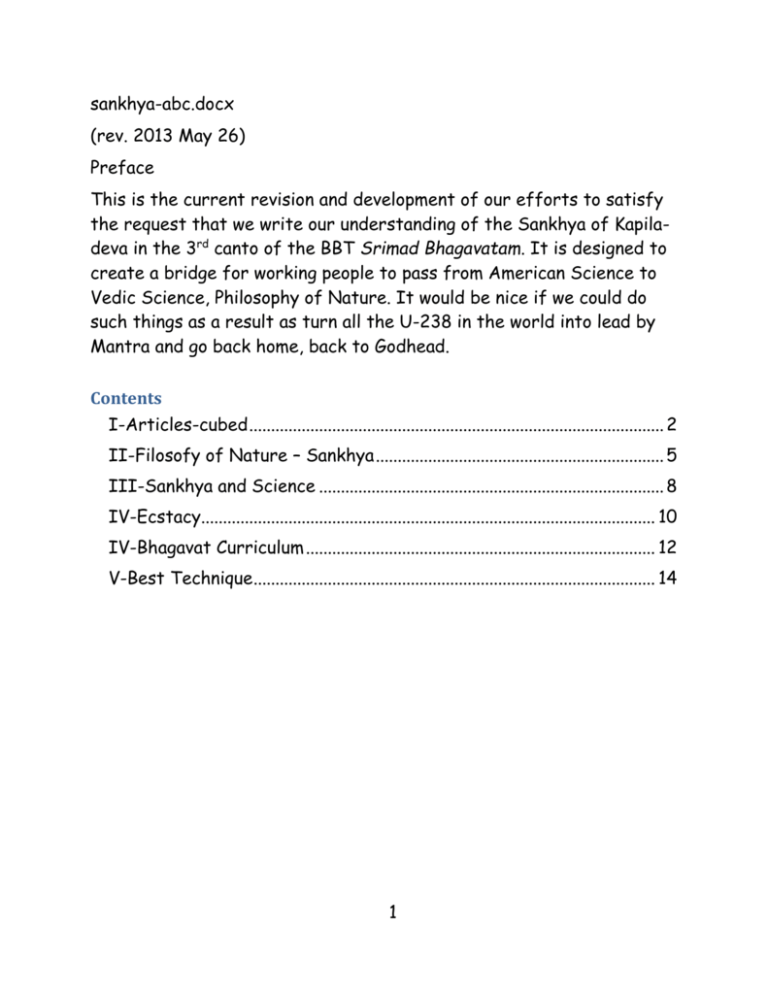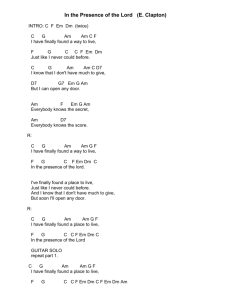
sankhya-abc.docx
(rev. 2013 May 26)
Preface
This is the current revision and development of our efforts to satisfy
the request that we write our understanding of the Sankhya of Kapiladeva in the 3rd canto of the BBT Srimad Bhagavatam. It is designed to
create a bridge for working people to pass from American Science to
Vedic Science, Philosophy of Nature. It would be nice if we could do
such things as a result as turn all the U-238 in the world into lead by
Mantra and go back home, back to Godhead.
Contents
I-Articles-cubed ............................................................................................... 2
II-Filosofy of Nature – Sankhya .................................................................. 5
III-Sankhya and Science ............................................................................... 8
IV-Ecstacy........................................................................................................ 10
IV-Bhagavat Curriculum ................................................................................ 12
V-Best Technique ............................................................................................ 14
1
I-Articles-squared
Hello, my name is Jack and I like to quack.
We dance the Bourbons plain.
We’re mendicants,
No castles lance,
N’er ere we hope to reign.
We’re destined, ‘proved,
Articles - Poems to scribe,
And then we will be gone.
AND NOW, THIS IS Buck White, Librarian to the Anjana Suta
Academy. The previous words were produced by one Tom Brown, also
known as Monkey, also of the Academy, and honestly speaking we are
known as Piggy.
It is a simple fact that we have been approved to write articles and
poetry for Krsna, so I guess we should get about the business. This is
2
our first article and it really seems that we should start with an article
about writing articles. This is as much, if not much more, for our
benefit than yours. We don’t know how to write. We are trying to
follow the example of successful writers like Zane Grey and Agatha
Christie. We are writing for people who probably have a university
education. You will see that we are writing more to change your
perspective than to communicate information, although this is
important too. I guess this is poetry as much as prose.
We hope to right absorbed in the association of writers.
We have been instructed to write articles and poetry in contrast to
novels or books because we are notorious as Wandering Miscreants.
Our Sannyasa, or Wandering Monk, Karma is so strong that it has been
repeatedly noted by excellent Vrajavasi palmists et al. So, we need to
write articles, things that can basically be done at one sitting and then
get them off to our Publisher as soon as possible. We can keep a few
things from them in our pockets as we travel for the sake of keeping
continuity between articles , but in general, travel means to pack light
and live off the land.
We pack the Nectar of Instruction of Prabhupada. We hang it
around our neck.
That’s enough, no? Always take the Holy Names and get good
intuition, read the NOI, and then write rather related articles for our
publisher.
PIGGY’S PARTING PEARLS
OUR MISSION IS to help Lord Caitanya in His mission of giving the
science of Krsna to everyone.
Albert Camus said that unless you rewrite six times you are a
coward. Of course, the best way to learn how to write articles is to
write articles. So we will introduce our realizations as we progress.
3
Hanuman didn’t spend a long time thinking what dangers he would find
on the other side of the ocean, he just said, “Jaya Rama!” and jumped.
MONKEY AGAIN
Articles and poems will splash from our pen,
So we can do good in the world of men.
4
II-Filosofy of Nature – Sankhya
The first thing we have been asked to write is an explanation of
Sankhya, Bhagavata Philosophy of Nature. Science is our AmericanEuropean philosophy of nature. The Bhagavad-gita and the Srimad
Bhagavatam both present this but he Srimad Bhagavatam is just like
30-times more detailed.
For example, at present we are using a dictaphone. The materialist who invented this
machine intended it for businessmen or writers of mundane subject matters. He
certainly never thought of using the dictaphone in God's service, but we are using this
dictaphone to write Kṛṣṇa conscious literature. Of course, the manufacture of the
dictaphone is wholly within the energy of Kṛṣṇa. All the parts of the instrument,
including the electronic functions, are made from different combinations and
interactions of the five basic types of material energy — namely, bhūmi, jala, agni, vāyu
and ākāśa. The inventor used his brain to make this complicated machine, and his brain,
as well as the ingredients, were supplied by Kṛṣṇa. According to the statement of Kṛṣṇa ,
mat-sthāni sarva-bhūtāni: "Everything is depending on My energy." Thus the devotee
can understand that since nothing is independent of Kṛṣṇa's energy, everything should
be dovetailed in His service. NOI-3 (Purport)
This leads us to (and it is profitable to investigate all the
references cited in the NOI) Bhagavad-gita 7.4
bhūmir āpo 'nalo vāyuḥ
khaḿ mano buddhir eva ca
ahańkāra itīyaḿ me
bhinnā prakṛtir aṣṭadhā
SYNONYMS
bhūmiḥ — earth; āpaḥ — water; analaḥ — fire; vāyuḥ — air; kham — ether; manaḥ —
mind; buddhiḥ — intelligence; eva — certainly; ca — and; ahańkāraḥ — false ego; iti —
thus; iyam — all these; me — My; bhinnā — separated; prakṛtiḥ — energies; aṣṭadhā
— eightfold.
TRANSLATION
Earth, water, fire, air, ether, mind, intelligence and false ego — all together these
eight constitute My separated material energies.
PURPORT
The science of God analyzes the constitutional position of God and His diverse energies.
Material nature is called prakṛti, or the energy of the Lord in His different puruṣa
incarnations (expansions) as described in the Sātvata-tantra:
5
viṣṇos tu trīṇi rūpāṇi
puruṣākhyāny atho viduḥ
ekaḿ tu mahataḥ sraṣṭṛ
dvitīyaḿ tv aṇḍa-saḿsthitam
tṛtīyaḿ sarva-bhūta-sthaḿ
tāni jñātvā vimucyate
"For material creation, Lord Kṛṣṇa's plenary expansion assumes three Viṣṇus. The first
one, Mahā-Viṣṇu, creates the total material energy, known as the mahat-tattva. The
second, Garbhodakaśāyī Viṣṇu, enters into all the universes to create diversities in each
of them. The third, Kṣīrodakaśāyī Viṣṇu, is diffused as the all-pervading Supersoul in all
the universes and is known as Paramātmā. He is present even within the atoms. Anyone
who knows these three Viṣṇus can be liberated from material entanglement."
This material world is a temporary manifestation of one of the energies of the Lord. All
the activities of the material world are directed by these three Viṣṇu expansions of Lord
Kṛṣṇa. These puruṣas are called incarnations. Generally one who does not know the
science of God (Kṛṣṇa) assumes that this material world is for the enjoyment of the
living entities and that the living entities are the puruṣas — the causes, controllers and
enjoyers of the material energy. According to Bhagavad-gītā this atheistic conclusion is
false. In the verse under discussion it is stated that Kṛṣṇa is the original cause of the
material manifestation. Śrīmad-Bhāgavatam also confirms this. The ingredients of the
material manifestation are separated energies of the Lord. Even the brahmajyoti, which
is the ultimate goal of the impersonalists, is a spiritual energy manifested in the spiritual
sky. There are no spiritual diversities in the brahmajyoti as there are in the
Vaikuṇṭhalokas, and the impersonalist accepts this brahmajyoti as the ultimate eternal
goal. The Paramātmā manifestation is also a temporary all-pervasive aspect of the
Kṣīrodakaśāyī Viṣṇu. The Paramātmā manifestation is not eternal in the spiritual world.
Therefore the factual Absolute Truth is the Supreme Personality of Godhead Kṛṣṇa. He is
the complete energetic person, and He possesses different separated and internal
energies.
In the material energy, the principal manifestations are eight, as above mentioned. Out
of these, the first five manifestations, namely earth, water, fire, air and sky, are called
the five gigantic creations or the gross creations, within which the five sense objects are
included. They are the manifestations of physical sound, touch, form, taste and smell.
Material science comprises these ten items and nothing more. But the other three
items, namely mind, intelligence and false ego, are neglected by the materialists.
Philosophers who deal with mental activities are also not perfect in knowledge because
they do not know the ultimate source, Kṛṣṇa. The false ego — "I am," and "It is mine,
which constitute the basic principle of material existence — includes ten sense organs
for material activities. Intelligence refers to the total material creation, called the
mahat-tattva. Therefore from the eight separated energies of the Lord are manifest the
twenty-four elements of the material world, which are the subject matter of Sāńkhya
6
atheistic philosophy; they are originally offshoots from Kṛṣṇa's energies and are
separated from Him, but atheistic Sāńkhya philosophers with a poor fund of knowledge
do not know Kṛṣṇa as the cause of all causes. The subject matter for discussion in the
Sāńkhya philosophy is only the manifestation of the external energy of Kṛṣṇa, as it is
described in the Bhagavad-gītā. (BBT, Bhagavad-gita As It Is, all rights reserved)
So, we will have to write about the difference between Devahutiputra Kapila Deva in the Bhagavatam and Anisvara Kapila who is well
known by modern Indologists. First let us see how the Sankhya of Lord
Kapila in the SB can be adjudicated to modern science.
7
III-Sankhya and Science
Some people believe that Science will tell us the truth in a reliable
way. Some also believe that there is God and that He is even more
reliable. A problem comes in the West for them in bridging the gap
between Scientific knowledge of gross matter and esoteric knowledge
of God. Besides other things Bhagavata Sankhya accomplishes this.
First it divides gross mater into five categories as described above:
That which we can hear, that which we can feel, that which we can see,
taste and smell. Pretty scientific, empirical. Then it describes three
subtle, psychological elements that it also takes as material. The self,
atma, is an element that dresses itself with different complexes of
thoughts and attitudes, and then different gross bodies from
different species of life.
Of course this is a big topic and also not easy for us gross barbaric
Westerners. The adjudication between the two systems can best be
made to our experience by reading the works of E. T. Hall who was a
esteemed cultural anthropologist absorbed in cross cultural studies of
time and space and more. Of course, what is Science but an attempt to
understand time and space and so forth.
Furthermore, combined with the Tavistock Lectures by Carl Jung
these give any sincere Westerner a full avenue into understanding that
the gross world of modern science is based upon subtler aspects of
gross matter, touch and sound, and then the psychological world.
Carl Jung: You think that these ancient Chinese and Indian sages were fools, but they
weren’t the fools, we are the fools, they were vastly intelligent. They understood things
that we are just beginning to understand.
If that is the case then why did they disappear? Because they were
eliminated by fundamental errors in the application of a science even
subtler than physics or psychology, theology. They ceased for various
natural reasons to be theodoros, lovers of God and that changed their
perspective and the gross world of atomic bombs, birth control pills
8
and dialysis shifted into the forefront. You don’t need Quantum
Mechanics to build a Boeing 747, but you do need Theology to
understand why to build it. Read Hall and Jung. Realize how different
cultures are seeing a different movie while sitting next to each other
in the same cinema.
9
IV-Ecstacy
The conclusion of all this mumble-jumbo is ecstasy. Yeah, you can
know science, you can know nature, from the Vedas or Von Braun, but
it’s all useless because the soul wants ECSTACY!
We meet so many big scientists, Nobel Laureates, theologians who
drink - whiskey on the rocks or wine. They’re not satisfied. Lord Kapila
describes this aspect of Sankhya to his student, His mother, in the
Srimad Bhagavatam.
SB 3.28.34: By following this course, the yogī gradually develops pure love for the
Supreme Personality of Godhead, Hari. In the course of his progress in devotional
service, the hairs on his body stand erect through excessive joy, and he is constantly
bathed in a stream of tears occasioned by intense love. Gradually, even the mind, which
he used as a means to attract the Lord, as one attracts a fish to a hook, withdraws from
material activity.
SB 3.28.35: When the mind is thus completely freed from all material contamination
and detached from material objectives, it is just like the flame of a lamp. At that time
the mind is actually dovetailed with that of the Supreme Lord and is experienced as one
with Him because it is freed from the interactive flow of the material qualities.
SB 3.28.36: Thus situated in the highest transcendental stage, the mind ceases from all
material reaction and becomes situated in its own glory, transcendental to all material
10
conceptions of happiness and distress. At that time the yogī realizes the truth of his
relationship with the Supreme Personality of Godhead. He discovers that pleasure and
pain as well as their interactions, which he attributed to his own self, are actually due to
the false ego, which is a product of ignorance.
Of course, this is not an artificial stage. In the beginning we do
science because we want freedom from distress: Cold, hunger, attack
from mosquitos, enemies. Yet in Ken Wilbur’s Quantum Questions he
gives numerous personal citations from the greatest scientists and
directly Einstein as representative comments that ultimately one does
science, undergoes the great, hour-long austerities of science, for
those moments when the beauty and harmony of nature reveals itself.
Sir Isaac Newton commented that he never took time off from
Theology to study Science, rather his investigations of mechanics,
optics, gravity between the ages of 18-22 years old were based upon
the premise that there are two books for understanding God: the Bible
and Nature, where God is writing with His own hand.
Personally we have developed some ability to stay on this ecstatic
platform after 40-years of being a student of His Divine Grace A. C.
Bhaktivedanta Swami Prabhupada. We feel that the reader could
probably make a lot faster progress and then give us a little help also.
Of course, once you have that taste you can only indulge in a lot of
arithmetic, calculus, grammar, rhetoric when it has that element of
ecstasy to it. That’s natural, that’s healthy, that’s human life.
11
IV-Bhagavat Curriculum
Sankhya is introduced in the Bhagavad-gita. We cited BG 7.4 above
which is maybe the most condensed verse, but the Srimad Bhagavatam
goes into more advanced knowledge. It also gives basis for Rupa
Goswami’s Bhakti-rasamrta sindhu which very analytically describes the
ecstatic position experienced by all genuine saints and yogis. As far as
we understand these are called beautific states of consciousness in
Catolic church and Bhava in Sri Rupa’s terminology. That’s a different
book.
In the Bhagavata there is a little bit in the first canto then a lot in
the last six chapters of the Second Canto. In the Third it is repeated
in the discussions between Maitreya and Vidura. Then the best
description is by Kapila Deva to His mother in the end of the Third
Canto. Let us first describe Buddhi. Do you remember the hierarchy
top down?
False Ego
Sub-conscience
Mind
Space
Texture
Color
Taste
Fragrance
We remember a poem by William Blake titled, “When Fallen Souls
Take to Burning Light”. Let’s look for it. The soul descends into the
material world being covered by a False Ego, “I am independent of God!
I am independent of Mommy and Daddy”. Then that False Ego
differentiates as Sub-conscious mind etc as we want to get into more
and more gross bodies, species. Let’s look at Buddhi, Sub-conscious,
Intellect first.
Carl Jung [ttd]
12
Jung and many psychologists have a good handle on this. That’s why
they are psychologists. The world we see, computer, table, wall is
produced by the sub-conscious mind integrating data from the senses
and producing a picture of the world we see. We can write for weeks on
this stuff. We’ll just take it a little at a time and expect that most of
it you will get in terms of your needs from actually applying what we
describe.
The intelligence is like the program and data files and the operating
system. The mind is like the CPU – Buddhi and Manas in Sanskrit.
“Advancement in Kṛṣṇa consciousness depends on the attitude of the
follower”- Preface to Prabhupada’s Nectar of Instruction
When the airplane lands it has to have the right “attitude” toward
the runway. These are pitch, roll and yawl. The nose can’t be too high.
The starboard wing can’t be higher than the port side wing. The
airplane can’t be coming down sideways. This is attitude. What is your
attitude toward life:
1. I am the supreme enjoyer. I am rich. All beautiful wimmen are for
my enjoyment.
2. I am a servant. Just because I am occupying space in this world I
have a debt to everyone I meet.
On the basis of that attitude we then think, calculate, evaluate and
will. I will steal the cake.
Buddhi intelligence, perspective,is in the heart. Manas, thinking is in
the head. Indriya sense activity and perception are in the senses. This
is the Mode of Goodness, Passion and Ignorance. They are prominent
respectively from 2-10AM, 10AM-6PM, 6PM-2AM. You can see, the
Happy Hour for the fools starts at 6PM or so when their club opens up
and alcohol is half-price.
13
If you get up at 2AM and use meditation and contemplation you can
build the attitude you want. Then when the sun comes up and it is time
to make money you will know why to make money.
It’s a little clearer? Thoughts, dreams, plans (all the same things)
are in our body of knowledge. As you are reading in Jung these are subconscious or in our conscious at different times. The world we
industrialized Dudes see is constructed by the sub-conscious. You are
getting that from Jung and E. T. Hall both.
What do you “see”, saxophone player or a
beautiful woman? Look at the right-hand silhouette.
V-Best Technique
14










